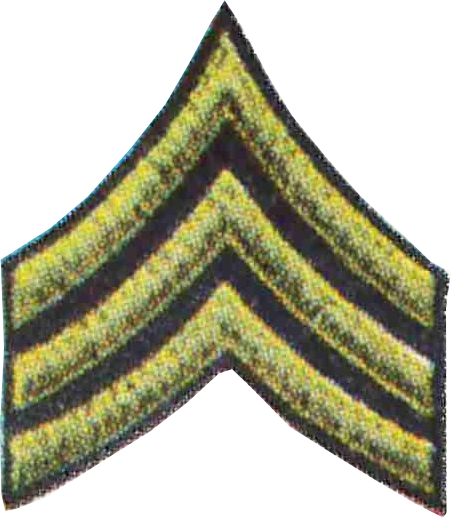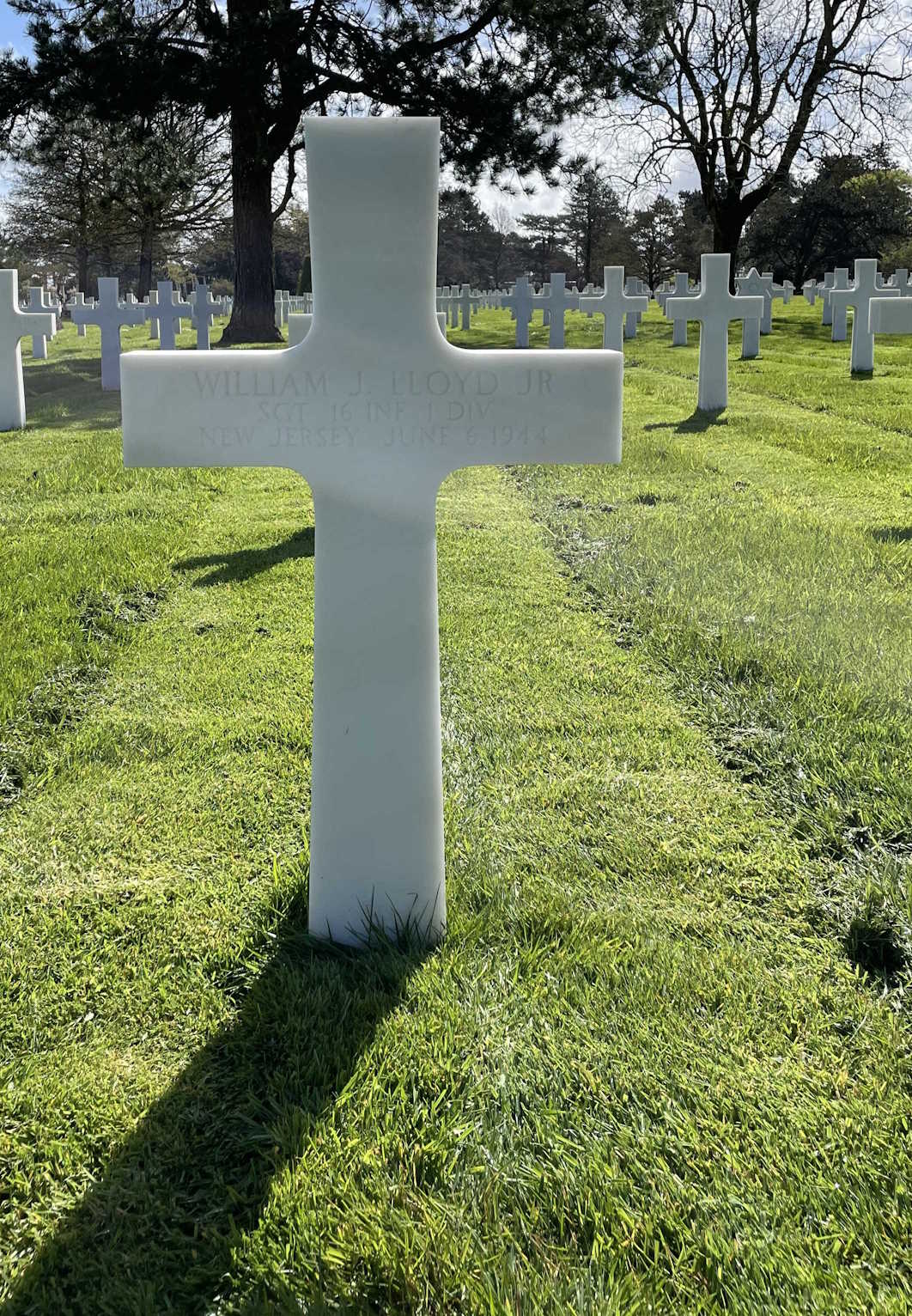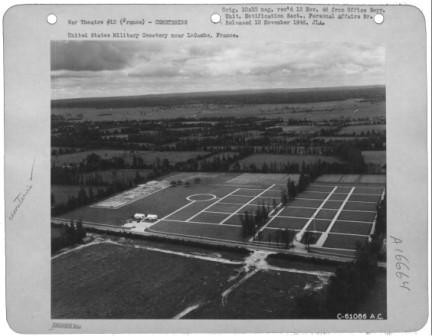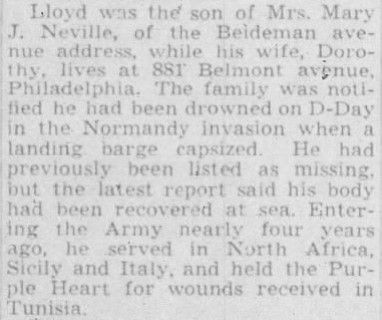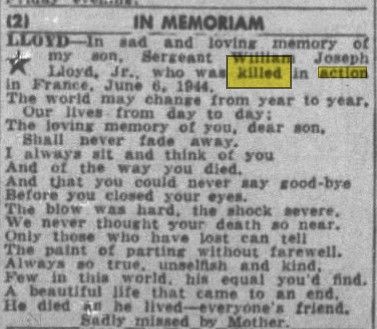|
William Joseph LLOYD Jr
| ||||||||||||||||||||||||||||
|---|---|---|---|---|---|---|---|---|---|---|---|---|---|---|---|---|---|---|---|---|---|---|---|---|---|---|---|---|
|
Source : srayl | ||||||||||||||||||||||||||||
| NUMBER OF SERVICE | 12010296 | |||||||||||||||||||||||||||
| AGE | 27 yo | |||||||||||||||||||||||||||
| DATE OF BIRTH |
1918 NEW JERSEY | |||||||||||||||||||||||||||
| ENLISTMENT STATE |
NEW JERSEY | |||||||||||||||||||||||||||
| FAMILY |
Spouse : Dorothy Kennerly Parents : William J & Mary Jane Jones LLOYD NEVILLE | |||||||||||||||||||||||||||
| RANK |
| |||||||||||||||||||||||||||
| FONCTION | Infantry Man | |||||||||||||||||||||||||||
| JOB BEFORE ENLISTEMENT | Railway employee |  | ||||||||||||||||||||||||||
| DATE of ENLISTEMENT | 16 October 1940 Camden NEW JERSEY | |||||||||||||||||||||||||||
| COMPANY | L Company | |||||||||||||||||||||||||||
| BATTALION | 3rd Battalion | |||||||||||||||||||||||||||
| REGIMENT | 16th Infantry Regiment | |||||||||||||||||||||||||||
| DIVISION | 1st Infantry Division | |||||||||||||||||||||||||||
| DATE OF DEATH | 6 June 1944 |
Source : Leonardo De Rosa | ||||||||||||||||||||||||||
| STATUS | KIA | |||||||||||||||||||||||||||
| PLACE OF DEATH | Omaha Beach | |||||||||||||||||||||||||||
| CEMETERY TEMPORARY |
CEMETERY TEMPORARY of La Cambe N°3539
| |||||||||||||||||||||||||||
| CEMETERY | NORMANDY AMERICAN CEMETERY of Colleville | |||||||||||||||||||||||||||
| GRAVE |
| |||||||||||||||||||||||||||
| DECORATION |
| |||||||||||||||||||||||||||
| ||||||||||||||||||||||||||||
| STORY | ||||||||||||||||||||||||||||
|
Source : Riley | ||||||||||||||||||||||||||||
|
William Joseph Lloyd Jr. was born in Spring 1918 in Camden, New Jersey. His parents, William J. Lloyd and Mary Jones, were married in Camden. William Jr. was their only child. He graduated from Woodrow Wilson High School in 1936 where he played on the football team. After high school William worked for the railroad until he enlisted in the US Army in October 1940. In April 1942 William married Dorothy Kennerly in Camden. He was sent overseas seven months later. William went to North Africa to join Company L, 3rd Battalion, 16th Infantry Regiment, 1st Infantry Division. The 16th Regiment had invaded French Morocco a month before he arrived and was moving east across North Africa. William was wounded in Tunisia and received the Purple Heart. In July 1943 he participated in the invasion of Sicily. When the island was secured in Fall 1943, the 16th Regiment was sent to England. They were based in Dorchester and began intensive training for an anticipated invasion of France. On D-Day the 3rd Battalion was one of the lead elements on Omaha Beach. The Army Air Force and Navy bombardments had not destroyed the German defenses as planned. Omaha Beach quickly became a scene of total chaos. Heavy seas made it difficult for landing craft to get close to shore. The German fire from all sizes of artillery with withering. Some men men were killed by fire or drowning before they reach the the beach. On the beach they encountered mines, barbed wire, and unrelenting artillery fire. Sergeant William J. Lloyd Jr, was Killed in Action on June 6, 1944. He was posthumously awarded a 2nd Purple Heart. Sgt. Lloyd is buried at the Normandy American Cemetery in Colleville-sur-Mer, France. By : suzstlouis | ||||||||||||||||||||||||||||
|
Source : Riley |
Source : Riley | |||||||||||||||||||||||||||
| | ||||||||||||||||||||||||||||
Activated/Activé |
Normandy/Normandie |
| 17 Jun 1917 | Days of Combat/Jour de Combat 443 |
| Casualties/Victimes 20 659 | |
Entered Combat/Entré au combat |
|
| 8 Nov 1942 North Africa | |
|
Commanding Generals/Commandants généraux Maj. Gen. Donald Cubbison (Feb 41 - Aug 42) |
Campaigns/CampagnesAlgeria-French Morocco (8 Nov 42 - 11 Nov 42)
|
PLAN DE ROUTE DE LA CAMPAGNE de MEDITERANNEE - CAMPAIGN ROUTE MAP |
|
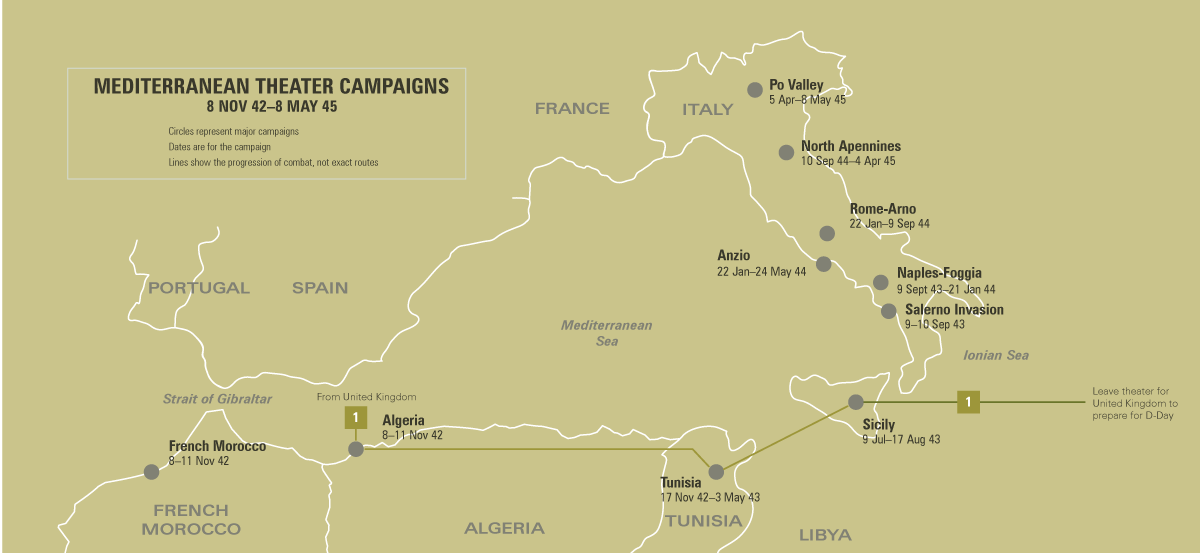 |
|
PLAN DE ROUTE DE LA CAMPAGNE - CAMPAIGN ROUTE MAP |
|
 |
|
DIVISION CHRONICLEThe 1st Infantry Division saw its first combat in World War II in North Africa, landing at Oran and taking part in the initial fighting, 8-10 November 1942. Elements then took part in seesaw combat at Maktar, Medjez el Bab, Kasserine Pass, Gafsa, El Guettar, Beja, and Mateur, 21 January-9 May 1943, helping secure Tunisia. The First was the first ashore in the invasion of Sicily, 10 July 1943 ; it fought a series of short, fierce battles on the island's tortuous terrain. When that campaign was over, the Division returned to England to prepare for the Normandy invasion. The First Division assaulted Omaha Beach on D-day, 6 June 1944, some units suffering 30 percent casualties in the first hour, and secured Formigny and Caumont in the beachhead. The Division followed up the St. Lo break-through with an attack on Marigny, 27 July 1944, and then drove across France in a continuous offensive, reaching the German border at Aachen in September. The Division laid siege to Aachen, taking the city after a direct assault, 21 October 1944. The First then attacked east of Aachen through Hurtgen Forest, driving to the Roer, and moved to a rest area 7 December for its first real rest in 6 months' combat, when the von Rundstedt offensive suddenly broke loose, 16 December. The Division raced to the Ardennes, and fighting continuously from 17 December 1944 to 28 January 1945, helped blunt and turn back the German offensive. Thereupon, the Division attacked and again breached the Siegfried Line, fought across the Roer, 23 February 1945, and drove on to the Rhine, crossing at the Remagen bridgehead, 15-16 March 1945. The Division broke out of the bridgehead, took part in the encirclement of the Ruhr Pocket, captured Paderborn, pushed through the Harz Mountains, and was in Czechoslovakia, at Kinsperk, Sangerberg, and Mnichov, when the war in Europe ended.
|
CHRONIQUE DE DIVISIONLa 1ère Division d'infanterie vit son premier combat en Afrique du Nord lors de la Seconde Guerre mondiale, débarquant à Oran et prenant part aux combats initiaux, du 8 au 10 novembre 1942. Les éléments participèrent ensuite aux combats en balançant à Maktar, Medjez el Bab, Col de Kasserine, Gafsa, El Guettar, Beja et Mateur, du 21 janvier au 9 mai 1943, contribuant à la sécurisation de la Tunisie. Le premier a été le premier à terre dans l'invasion de la Sicile, le 10 juillet 1943; il a combattu une série de batailles courtes et féroces sur le terrain tortueux de l'île. Quand cette campagne fut terminée, la Division revint en Angleterre pour se préparer à l'invasion de la Normandie. La première division a attaqué Omaha Beach le jour J, le 6 juin 1944, certaines unités subissant 30% de pertes au cours de la première heure et sécurisant Formigny et Caumont dans la tête de pont. La Division a suivi la percée de Saint-Lô avec une attaque sur Marigny, le 27 juillet 1944, puis a traversé la France dans une offensive continue, atteignant la frontière allemande à Aix-la-Chapelle en septembre. La Division a assiégé Aix-la-Chapelle après un assaut direct, le 21 octobre 1944. Le Premier a ensuite attaqué à l'est d'Aix-la-Chapelle par Hurtgen Forest, jusqu'à la Roer, et s'est installé dans une aire de repos le 7 décembre pour son premier repos. combat de mois, quand l'offensive de von Rundstedt se déchaîna subitement, le 16 décembre. La division a couru vers les Ardennes, et combat continuellement du 17 décembre 1944 au 28 janvier 1945, a aidé à émousser et à retourner l'offensive allemande. La Division attaqua de nouveau la ligne Siegfried, traversa la Roer, le 23 février 1945, et se dirigea vers le Rhin, traversant la tête de pont de Remagen, du 15 au 16 mars 1945. La division sortit de la tête de pont. dans l'encerclement de la poche de la Ruhr, capturé Paderborn, poussé à travers les montagnes du Harz, et était en Tchécoslovaquie, à Kinsperk, Sangerberg et Mnichov, lorsque la guerre en Europe a pris fin.
|
| SOURCE INFORMATION & PHOTO | Armydivs.squarespace.com |
|---|
| SOURCE INFORMATION & SOURCE PHOTO | Aad.archives.gov - Findagrave.com - Abmc.gov - Fold3 |
|---|---|
| PROGRAMMER | Victor, Jean-Philippe, Eric, Henri, Garrett, Clive, Frédéric & Renaud |





















